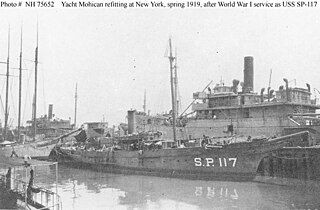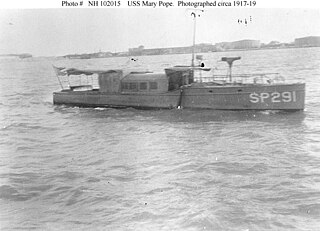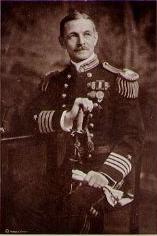
USS Montana (ACR-13/CA-13), also referred to as "Armored Cruiser No. 13", later renamed Missoula and reclassified CA-13, was a Tennessee-class armored cruiser of the United States Navy. She was built by the Newport News Drydock & Shipbuilding Co.; her keel was laid down in April 1905, she was launched in December 1906, and she was commissioned in July 1908. The final class of armored cruisers to be built for the US Navy, Montana and her sisters were armed with a main battery of four 10-inch (254 mm) guns, and they were capable of a top speed of 22 knots.

The second USS Suwannee and third USS Mayflower was a United States Lighthouse Board, and later United States Lighthouse Service, lighthouse tender transferred to the United States Navy in 1898 for service as an auxiliary cruiser during the Spanish–American War and from 1917 to 1919 for service as a patrol vessel during World War I. She also served the Lighthouse Board and in the Lighthouse Service as USLHT Mayflower from 1897 to 1898, from 1898 to 1917, and from 1919 to 1939, and in the United States Coast Guard as the first USCGC Mayflower (WAGL-236) in 1939 and from 1940 to 1943 and as USCGC Hydrangea (WAGL-236) from 1943 to 1945.

USS Kanawha II (SP-130)/USS Piqua (SP-130) -- was a yacht acquired by the U.S. Navy during World War II. She was placed into service as an escort for Allied convoys traveling across the dangerous North Atlantic Ocean. German U-boats were active in sinking Allied ships, and Kanawha II provided a valuable service as a lookout and in one instance attacked one and drove it off. Post-war she was returned to her pre-war owner in July 1919.

An armed yacht was a yacht that was armed with weapons and was typically in the service of a navy. The word "yacht" was originally applied to small, fast and agile naval vessels suited to piracy and to employment by navies and coast guards against smugglers and pirates. Vessels of this type were adapted to racing by wealthy owners. The origin of civilian yachts as naval vessels, with their speed and maneuverability, made them useful for adaptation to their original function as patrol vessels. In the United States Navy armed yachts were typically private yachts expropriated for government use in times of war. Armed yachts served as patrol vessels during the Spanish–American War and the World Wars. In the latter conflicts, armed yachts were used as patrol vessels, convoy escorts, and in anti-submarine duties. In the United States, yachts were purchased from their owners with the owners given an option to repurchase their yacht at the close of hostilities.

USS Lynx II (SP-730), later USS SP-730, was an armed motorboat that served in the United States Navy as a patrol vessel and harbor dispatch boat from 1917 to 1919.

The fifth USS Despatch (SP-68), later PY-8, originally USS Vixen (SP-68), was a yacht that served in the United States Navy as a tender from 1917 to 1919 and from 1920 to 1921.

USS Texan (ID-1354) was a United States Navy cargo ship and troop transport in commission from 1918 to 1919.

The third USS Mohican (SP-117), later USS SP-117, was an armed yacht that served in the United States Navy as a patrol vessel from 1917 to 1919.

USS Nirvana (SP-706), later USS SP-706, was a United States Navy patrol vessel in commission in 1917 and from 1918 to 1919.

USS Mary Pope (SP-291) was a United States Navy patrol vessel in commission from 1917 to 1919.

USS Navajo III (SP-298), later USS SP-298, was an armed motorboat that served in the United States Navy as a patrol vessel from 1917 to 1919.

USS Sans Souci II (SP-301) was an armed motorboat that served in the United States Navy as a patrol vessel from 1917 to 1919.

USS Aurore II (SP-460) was a United States Navy patrol vessel in commission from 1917 to 1919.

USS Aramis (SP-418/PY-7) was a yacht acquired by the United States Navy during World War I which served as a patrol boat off New York City, was then fitted with an experimental "underwater detection system" and depth charges as an anti-submarine vessel, and was briefly the flagship of a battleship squadron. She ended her career as a tender and houseboat to a survey vessel off the coast of Cuba, until disposed of in 1933.

USS Owaissa (SP-659) was a United States Navy patrol vessel in commission from 1917 to 1919.

USS See W. See (SP-740) was a United States Navy patrol vessel in commission from 1917 to 1919.

The first USS Vision (SP-744), later USS SP-744, was a United States Navy patrol vessel in commission from 1917 to 1919.

The second USS Itasca (SP-810), later USS SP-810, was a United States Navy patrol vessel in commission from 1917 to 1919 which was employed as a hospital boat.

United States Navy operations during World War I began on April 6, 1917, after the formal declaration of war on the German Empire. The American navy focused on countering enemy U-boats in the Atlantic Ocean and the Mediterranean Sea, while convoying men and supplies to France and Italy. Because of United States' late entry into the war, her capital ships never engaged the German fleet, and few decisive submarine actions occurred.

Rear Admiral Spencer Shepard Wood was a United States Navy officer. His career included service in the Spanish–American War and World War I, command of battleships and cruisers, and duty as an aide to a number of senior naval leaders.




















